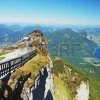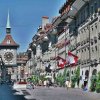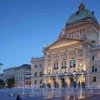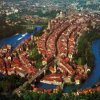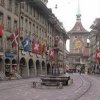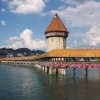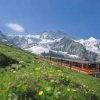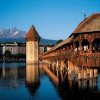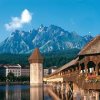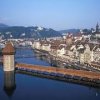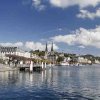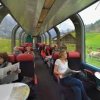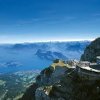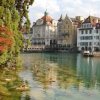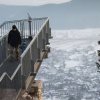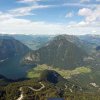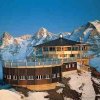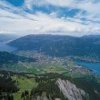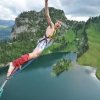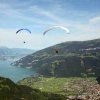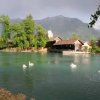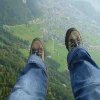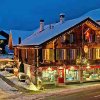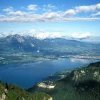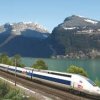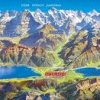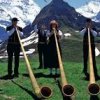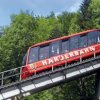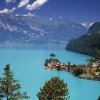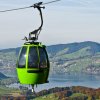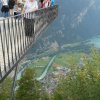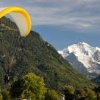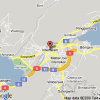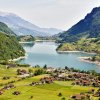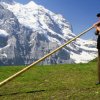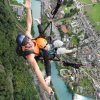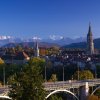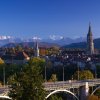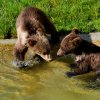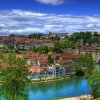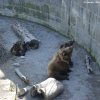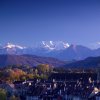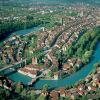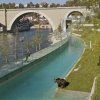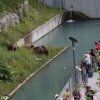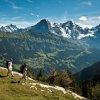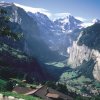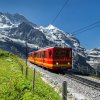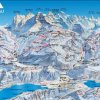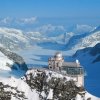ATTRACTIONS IN INTERLAKEN
The small town of Interlaken offers a wide variety of attractions and activities both in the summer and winter months. The main thoroughfare of Interlaken is the Höheweg promenade which links the more urban centre of Interlaken West with the less populated Interlaken East. It is one of the best locations for souvenir and watch shopping and there are plenty of cafes, hotels and restaurants along here as well. It is a good place to stroll down and a lot of the attractions of Interlaken are on or near here.
Starting just near Interlaken East you can take a lovely walk on a path running beside the River Aare. On a warm summer day this is a lovely treat away from the busy centre of Interlaken. You could also start this walk from the other end near Interlaken West. If you would like a longer walk then you can also walk along the banks of the River Aare from Lake Thun to Lake Brienz.
A really pleasant but slightly longer walk is one starting from the centre of Interlaken to the sluice gates at Unterseen, along the Goldey promenade, past the Bödelibad (open-air & indoor swimming pools) towards the Harder Kulm Funicular. You then walk alongside the River Aare to the railway viaduct at the beginning of Lake Brienz. You can then walk up along the path to Ringgenberg, along the lakeside promenade to Bönigen or along the other side of the river back to Interlaken.
Harder Kulm
Harder Kulm is a lookout point with wonderful views over the town of Interlaken, Brienz and Thun Lakes as well as the entire Jungfrau Region. There is a restaurant at the top where you can enjoy a drink and some food whilst you take in the glorious views.You take a 10 minute train ride via a funicular railway to the mountain top. The valley station is found near Interlaken East railway station.
For more information about Harder Kulm visit the following website at: http://www.jungfrau.ch/en/tourism/places-to-visit/
If the air is misty around Interlaken it probably isn’t worth going up the funicular to Harder Kulm as the view will be disappointing.
Interlaken Castle
The Interlaken Castle is home to the Interlaken Treaty Organisation and its setting is beautiful with its formal gardens at the entrance and the backdrop of mountains in the distance. Most people visiting here will want to see the Tin Figure Exhibition that is located in the castle. This exhibition displays over 100,000 tin figures grouped in around 150 scenes from world history. The exhibition is only open in the summer so check the website for details. Presently it is open 16 - 19 June from 12pm until 6pm and then in July and August from Tuesday to Saturday from 2pm until 5pm.
Garden of Friendship
This small garden is found on Höheweg next to the Hotel Interlaken. The Garden of Friendship is the first Japanese garden in Switzerland and it symbolises friendly relationships between the cities of Interlaken and Otsu in Japan. The garden was created in 1995 by a landscape gardener from Otsu and represents traditional Japanese gardens, with plenty of water, flora, koi carp and is very peaceful.
Höheweg
This is the main street in Interlaken and it stretches from the central square to the east. This street is home to a huge number of fashionable hotels, restaurants, cafes, local shops and night venues. Of particular note is the 150 year old Victoria Jungfrau Hotel. You may want to look inside this grand hotel or have a meal at its outdoor restaurant. Day and night, Höheweg is where you will see the majority of tourists as it is a shopping and entertainment centre. It is also the place to get some lovely views of the Jungfrau Mountain as well as the hills around the town. From mid-April to October there is a train that takes you around Interlaken and its sights. It takes 30 minutes and you depart from the stop found opposite the Victoria-Jungfrau Hotel. Costs are Adults CHF 9.00, children (4-12) CHF 4.50, Family (2 adults + 1-2 children) CHF 20.00.
Höhematte
This meadow is found in the middle of Interlaken along Höheweg. It covers around 14 hectares and from here you can get some stunning views of the surrounding mountains. It is always filled with seasonal flowers and it is a favourite place for various sporting activities including the landing spot for many paragliders. In the Höhematte you will find a theatre, a coffee shop, a historical Augustinian convent and church and a working clock made of flowers. This was once the property of Augustinian monks but it was acquired in the mid-19th century by the hotel keepers of Interlaken, who turned it into a park.
Adventure Sports
Interlaken is a centre for many types of sporting activities both in the summer and winter months. One of the most popular activities is paragliding/hang gliding and often you will see people landing in the Höhematte or gliding over the nearby hills. In winter skiing is very popular and with a number of ski regions found in close proximity to Interlaken you will always find one to suit. The best place to find information about the different sports and activities that are available and the companies offering them is to visit the Interlaken Tourist website at: http://www.interlaken.ch.
Casino Kursaal
The setting for this casino and convention centre is just stunning with its beautiful gardens, fountain and magnificent mountain backdrop. It is worth a visit here to look at the grounds. Interlaken is a favourite destination for conferences because of its central location and lots of hotels. The building itself dates from 1859 and was built on the site of a former Augustinian monastery.
For more information about Casino Kursaal visit the website at: http://www.congress-interlaken.ch
Covered Bridge
This is an alternate route to cross the River Aare. It is a lovely old covered wooden bridge which stands on a concrete foundation and provides wonderful views over the river and the surrounding landscape.
Unterseen
Unterseen is found across the River Aare near Interlaken West railway station. In Unterseen are some lovely examples of lovely wooden buildings that exemplify the ‘typical’ swiss chalet for many people but are usually only found out in the countryside. Also in this area you will find farmers that keep animals in their gardens. This area has a more historic feel to it than Interlaken and it isn’t touristy. There are hotels to stay in that are quiet and quaint as well as many restaurants and cafes serving Swiss food. It is a lovely place to wander around and to take a break from the faster pace of its neighbour.
Stadthausplatz
Stadthausplatz can be found on the left bank of Interlaken in the area known as Unterseen. It is a small pleasant square that is home to a number of cafes, terraces, restaurants, and shops. You will also find here a tall old chapel, constructed with small stones.
Tourist Museum
The Interlaken Tourist Museum is the place to learn more about the Jungfrau area and how the town has been influenced by the influx of winter tourists over the past 200 years. There are three floors of displays of costumes, carriages and other curios. It is found in a renovated 17th century building in Unterseen at number 28 Obere Gasse and it is open from May to October from Tuesday to Sunday from 2pm until 5pm. Costs are CHF5 for adults and CHF2 for children.
For more information about the museum visit the website at: http://www.touristikmuseum.ch (in German only)
Horse Drawn Carriage Rides
Carriages can be hired so you can enjoy a peaceful ride and take in the sights of Interlaken in a leisurely way for 30 minutes up to an hour. They depart from outside Interlaken West Railway Station on Höheweg. They cost CHF40 for 1 or 2 people and each additional person costs CHF10. Children between 7 and 16 are half price.
Boat Trips on the Lakes
You can take boat trips on Lake Thun or Lake Brienz either on a motor-powered vessel or on an elegant, restored paddle-wheel steamboat. Special themed trips can also be taken as well as evening trips with entertainment. There are plenty of facilities on board including excellent dining and banquet services. The boats depart from the boat landing near Interlaken West train station. You can take a half or a full day excursion depending on what you want to see. Lake Thun has numerous churches, fortresses and farmhouses as well as five magnificent castles which you can visit. Lake Brienz has beautiful turquoise water and there are several places to visit around its shores. It has a magnificent natural setting with mountains all around as well as waterfalls that plunge from great heights into the lake.
For more information about the boat trips and what they cost visit the website at: http://www.bls.ch/e/schifffahrt/schifffahrt.php
A good website that will give you more information about the boat trips and what you can see is Interlaken Tourism which is found at:
You can purchase your tickets at the ticket office at the boat landing or they can be purchased on board at the ticket office on the boat.
Heimwehfluh
A funicular built between 1904 and 1906 takes you up a short trip from the valley station found near Interlaken West railway station to a small hill called Heimwehfluh which is situated above Interlaken. As well as the stunning view there are numerous attractions found here including beautiful woodland paths, an open-air model railway, a bobsled run from the top all the way down to the base station in Interlaken and a spacious play area for children. The summit restaurant serves a choice of snacks. The funicular operates from April to October every day from 10am until 5pm. There are combination tickets that include all the attractions as well as the funicular and these cost CHF23 for adults and CHF14 for children (6 to 16). The different attractions are also priced individually and they are as follows: Return trip on the funicular is CHF14 for adults and CHF7 for children; model railway and the rodelbahn each cost CHF9 for adults and CHF7 for children; the bobsled run costs CHF6 for adults and children.
For more information about Heimwehfluh visit the website at: http://www.heimwehfluh.ch (in German only)
Mystery World
Mystery World was designed by Erich von Daniken and features seven pavilions that explore possible explanations and solutions to some of the major secrets of the world. The seven pavilions are: Challenge which is about outer space and visits to Mars; Vimana which is about the flying vehicles mentioned in two Indian stories, Mahabharata and Ramayana; Nazca which is about the secret of Nazca lines close to Peru; Orient which discusses the mysteries related to the Pyramid at Giza; Mega Stones which tries to solve the mysteries related to the Stone Age; Contact which is about the concept of cargo cults and Maya which is about the Mayan calendar. You can enjoy riddles and multimedia presentations that excite and educate you during your tours here.
BERN
JUNGFRAU
The Jungfrau (German: "maiden/virgin"; 4,158 metres (13,642 ft)) is one of the main summits of the Bernese Alps, located between the southern canton of Bern and the northern canton of Valais, halfway between Interlaken and Fiesch. Together with the Eiger and Mönch, the Jungfrau forms a massive wall overlooking the Bernese Oberland and the Swiss Plateau, one of the most distinctive sights of the Swiss Alps.
The summit was first reached on August 3, 1811 by the Meyer brothers of Aarau and two chamois hunters from Valais. The ascent followed a long expedition over the glaciers and high passes of the Bernese Alps. It was not until 1865 that a more direct route on the northern side was opened.
The construction of the Jungfrau railway in the early 20th century, which connects Kleine Scheidegg to the Jungfraujoch, the saddle between the Mönch and the Jungfrau, made the area one of the most-visited places in the Alps. Along with the Aletsch Glacier to the south, the Jungfrau is part of the Jungfrau-Aletsch area, which was declared a World Heritage Site in 2001.
The Jungfrau and the valley of Lauterbrunnen from InterlakenThe Jungfrau is the westernmost and highest point of a gigantic 10 km wall dominating the valleys of Lauterbrunnen and Grindelwald. The wall is formed by the alignment of some of the biggest north faces in the Alps, with the Mönch (4,107 m) and Eiger (3,970 m) to the east of the Jungfrau, and overlooks the valleys to its north by a height of up to 3 km. The Jungfrau is approximately 6 km from the Eiger; with the summit of the Mönch between the two mountains, 3.5 km from the Jungfrau. The wall is extended to the east by the Fiescherwand and to the west by the Lauterbrunnen Wall.
The difference of altitude between the deep valley of Lauterbrunnen (800 m) and the summit is particularly visible from the area of Mürren. From the valley floor, west of the massif, the altitude gain is more than 3 km for a horizontal distance of 4 km.
The landscapes around the Jungfrau are extremely contrasted. Instead of the vertiginous precipices of the north-west, the south-east side emerges from the upper snows of the Aletsch Glacier at around 3,500 metres. The 20 km long valley of Aletsch on the south-east is completely uninhabited and also surrounded by other similar glacier valleys. The whole area constitutes the largest glaciated area in the Alps as well as in Europe.[4]
Jungfraujoch and tourism
While the mountain peak was once difficult to access, the Jungfraubahn cog railway now goes to the Jungfrau railway station at 3,454 m (11,332 ft), the highest in Europe. The Jungfraujoch is the lowest pass between the Jungfrau and Mönch.
In 1893 Adolf Guyer-Zeller conceived of the idea for a railway tunnel to the Jungfraujoch to make the glaciated areas on the south more accessible. The building of the tunnel took 16 years and the summit station was not opened before 1912. The goal was in fact to reach the summit of the Jungfrau with an elevator from the highest railway station inside the mountain. The complete project was not realized because of the outbreak of the World War I.[5]Jungfrau east wall from the Jungfraujoch
The train into the mountain leaves from Kleine Scheidegg, which can be reached by trains from Grindelwald and Lauterbrunnen via Wengen. The train enters the tunnel running eastward through the Eiger shortly above Kleine Scheidegg. Before arriving at the Jungfraujoch, it stops for a few minutes at two other stations, Eigerwand (on the north face of the Eiger) and Eismeer (on the south side), where passengers can see through the holes excavated from the mountain. The journey from Kleine Scheidegg to Jungfraujoch takes approximately 50 minutes including the stops; the downhill return journey taking only 35 minutes.
A large complex of tunnels and buildings has been constructed at the Jungfraujoch, mostly into the south side of the Mönch. There is a hotel, two restaurants, an observatory, a research station, a small cinema, a ski school, and the "Ice Palace", a collection of elaborate ice sculptures. Another tunnel leads outside to a flat, snow-covered area, where one can walk around and look down to the Konkordiaplatz and the Aletsch Glacier, as well as the surrounding mountains.
Apart from the Jungfraujoch, many facilities have been built in the two valleys north of the Jungfrau (the commonly named Jungfrau Region). In 1908, the first public cable car in the world opened at the foot of the Wetterhorn, but was closed seven years later.[12] The Schilthorn above Mürren or the Männlichen above Wengen offer good views of the Jungfrau and other summits.

